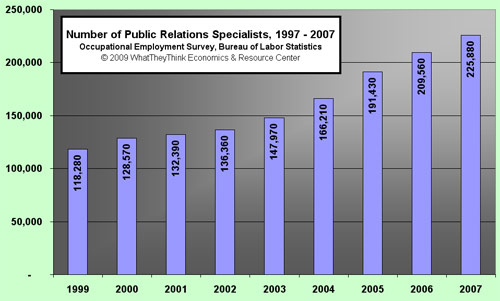We all know the communications business has changed, but it's often hard to know by how much. This is one of the reasons why I look at measures of economic activity based on employment. Workers go where the work is, and in that case, the growth of public relations is notable. The chart below shows the change in employment in the job category “public relations specialists” as tracked by the Bureau of Labor Statistics. It's not just the employment in public relations businesses, it includes PR specialists in corporate and other organizational settings.

The Internet bubble and the recession of 2001 did not deter the march of this critical promotional discipline. More than 100,000 specialists were added between 1999 and 2007. They are likely to survive these current times better than other promotional strategy workers.
Public relations was essentially media relations for most of its history. Magazines, newspapers, broadcast media were the primary methods to reach the public, excluding advertising, of course. There were even public relations professionals who were paid on the basis of how often a company's name appeared in trade publications. PR firms would track this carefully, making copies of each story or image, and then presenting it to the client in a nice book or binder when it came time for contract renewal. Some PR professionals would chuckle that this was not much different than a cat presenting a dead mouse to its human owner, proving the cat's worth. (Some who own cats and know their fierce independence have wondered if it's not the cat saying “if you're not careful, you're next.”)
The sea change for PR was the Internet and its search engines. As consumers and businesspeople began to do their information search directly, bypassing traditional media, the strategy of public relations changed. Instead of schmoozing with the media, and writing press releases to catch the attention of an editor or writer, PR began to see a new strategy, that of going direct to the customers and prospects of their clients.
Now public relations specialists are playing more critical roles in their companies, at the forefront of web site content direction and presentation, search engine optimization, creating and managing company blogs, podcasts, video efforts, and having bigger roles in the development of events and promotions.
The newest area for public relations professionals is the guiding of companies to use social media in a strategic and systematic way. Facebook, Twitter, LinkedIn, and many other social media formats that are still emerging, are now part of the PR toolbox.
With these new roles, come new relationships that print businesses can have with these practitioners. While ad agencies will continue to be important to printing businesses, any printing business that does not address the growing role or PR specialists is leaving opportunity on the table. Get involved in local chapters of the Public Relations Society of America. Read the book “The New Rules of Marketing and PR: How to Use News Releases, Blogs, Podcasting, Viral Marketing and Online Media to Reach Buyers Directly.” Read it in a manner where you think about it for your own business but also how you might be able to provide these services to PR professionals and their clients.
Remember, all of these new media give wider choices to the information users. They can choose when, how, and where, they will access information. They do so unpredictably. This is why the communications job has actually gotten harder. You have to be everywhere, strategically. It demands specialists who are literate in all communications forms. That's why it can be our industry's opportunity, too. Take the first step.














